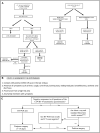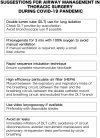Perspectives in surgical and anaesthetic management of lung cancer in the era of coronavirus disease 2019 (COVID-19)
- PMID: 32844172
- PMCID: PMC7499647
- DOI: 10.1093/ejcts/ezaa295
Perspectives in surgical and anaesthetic management of lung cancer in the era of coronavirus disease 2019 (COVID-19)
Abstract
Early in 2020, coronavirus disease 2019 (COVID-19) quickly spread globally, giving rise to a pandemic. In this critical scenario, patients with lung cancer need to continue to receive optimal care and at the same be shielded from infection with the potentially severe acute respiratory syndrome coronavirus 2. Upgrades to the prevention and control of infection have become paramount in order to lower the risk of hospital contagion. Aerosol-generating procedures such as endotracheal intubation or endoscopic procedures may expose health care workers to a high risk of infection. Moreover, thoracic anaesthesia usually requires highly complex airway management procedures because of the need for one-lung isolation and one-lung ventilation. Therefore, in the current pandemic, providing a fast-track algorithm for scientifically standardized diagnostic criteria and treatment recommendations for patients with lung cancer is urgent. Suggestions for improving existing contagion control guidelines are needed, even in the case of non-symptomatic patients who possibly are responsible for virus spread. A COVID-19-specific intraoperative management strategy designed to reduce risk of infection in both health care workers and patients is also required.
Keywords: 2019-nCoV; Coronavirus; Coronavirus disease 2019; Infection prevention and control; Lung cancer; SARS; Thoracic anaesthesia.
© The Author(s) 2020. Published by Oxford University Press on behalf of the European Association for Cardio-Thoracic Surgery. All rights reserved.
Figures



Similar articles
-
Surgical Infection Society Guidance for Operative and Peri-Operative Care of Adult Patients Infected by the Severe Acute Respiratory Syndrome Coronavirus-2 (SARS-CoV-2).Surg Infect (Larchmt). 2020 May;21(4):301-308. doi: 10.1089/sur.2020.101. Epub 2020 Apr 20. Surg Infect (Larchmt). 2020. PMID: 32310715 Review.
-
Infection Prevention Precautions for Routine Anesthesia Care During the SARS-CoV-2 Pandemic.Anesth Analg. 2020 Nov;131(5):1342-1354. doi: 10.1213/ANE.0000000000005169. Anesth Analg. 2020. PMID: 33079853 Review.
-
Impact of a 10 Rules Protocol on COVID-19 Hospital-Related Transmission: Insights From Padua University Hospital, Italy.Circ Cardiovasc Interv. 2020 May;13(5):e009279. doi: 10.1161/CIRCINTERVENTIONS.120.009279. Epub 2020 May 15. Circ Cardiovasc Interv. 2020. PMID: 32408822 No abstract available.
-
Guidance for otolaryngology health care workers performing aerosol generating medical procedures during the COVID-19 pandemic.J Otolaryngol Head Neck Surg. 2020 Jun 3;49(1):36. doi: 10.1186/s40463-020-00429-2. J Otolaryngol Head Neck Surg. 2020. PMID: 32493489 Free PMC article. Review.
-
COVID-19: are frontline surgical staff ready for this?Br J Surg. 2020 Jun;107(7):e195. doi: 10.1002/bjs.11663. Epub 2020 May 4. Br J Surg. 2020. PMID: 32364245 Free PMC article. No abstract available.
Cited by
-
COVID-19 Pandemic: Advances in Diagnosis, Treatment, Organoid Applications and Impacts on Cancer Patient Management.Front Med (Lausanne). 2021 Mar 29;8:606755. doi: 10.3389/fmed.2021.606755. eCollection 2021. Front Med (Lausanne). 2021. PMID: 33855032 Free PMC article. Review.
-
Thoracic Surgery in the COVID-19 Pandemic: A Novel Approach to Reach Guideline Consensus.J Clin Med. 2021 Jun 24;10(13):2769. doi: 10.3390/jcm10132769. J Clin Med. 2021. PMID: 34202563 Free PMC article.
-
The impact of the COVID-19 pandemic on care delivery and quality of life in lung cancer surgery.J Surg Oncol. 2022 Sep;126(3):407-416. doi: 10.1002/jso.26902. Epub 2022 Apr 23. J Surg Oncol. 2022. PMID: 35460517 Free PMC article.
-
Management of lung cancer patients during COVID-19 pandemic: dos, don'ts and don't knows.Explor Target Antitumor Ther. 2022;3(3):321-336. doi: 10.37349/etat.2022.00085. Epub 2022 Jun 10. Explor Target Antitumor Ther. 2022. PMID: 36045909 Free PMC article. Review.
-
Cancer du poumon à l’ère du COVID-19: Lung cancer in the COVID-19 era.Rev Malad Respir Actual. 2020 Dec;12(2):2S378-2S382. doi: 10.1016/S1877-1203(20)30155-5. Epub 2020 Dec 5. Rev Malad Respir Actual. 2020. PMID: 33312269 Free PMC article. French.
References
-
- Maconachie R, Mercer T, Navani N, Mcveigh G.. Lung cancer: diagnosis and management: summary of updated NICE guidance. BMJ 2019;364:1–4. - PubMed
-
- Lüchtenborg M, Riaz SP, Coupland VH, Møller H, Lim E, Page R. et al. High procedure volume is strongly associated with improved survival after lung cancer surgery. J Clin Oncol 2013;31:3141–6. - PubMed
MeSH terms
LinkOut - more resources
Full Text Sources
Medical
Miscellaneous

